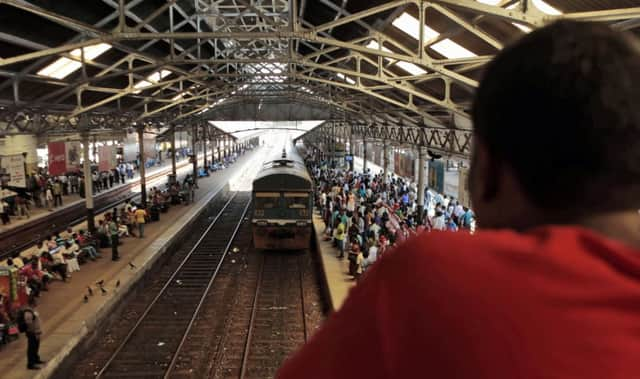Can Queen of Jaffna train’s reunite Sri Lanka?


The return of the Queen of Jaffna marks a step toward restoring national unity five years after the government defeated Tamil separatists.
President Mahinda Rajapaksa will inaugurate the service along the 250-mile route between Jaffna and the capital Colombo, in a ceremony tomorrow. Rebuilding the railway, stretches of which disappeared as rebels and residents used rails and sleepers to build bunkers and houses, is one of the government’s big infrastructure projects to contribute to the economy in the north and win over Tamils, many of whom are still estranged after the war.
Advertisement
Hide AdAdvertisement
Hide AdLike the old version, the new Queen of Jaffna is not a luxury train, although some of its coaches will have air conditioning, internet access and televisions. The new track will make for a faster, smoother ride, with the trip taking about six hours.
The line was shut down in 1990 as militants from the Liberation Tigers of Tamil Eelam, or Tamil Tigers, stepped up attacks in the north to push for their own independent state.
The train is important symbolically. Before the war, as well as being the most convenient way to travel between the two cities, it was also a symbol of unity between the Sinhalese majority and Tamil minority. At the time, Tamils dominated bureaucratic and state service posts, and many civil servants based in Colombo used it to visit friends and family in the north.
“We took the train to Jaffna for weekends and came back by the same on Sunday evenings,” said Karuna Navaratnam, a 69-year-old retired teacher, who travelled on the route frequently in the 1970s.
Now settled in Colombo, Navaratnam recalled the train travelling through rice paddies and farms on its way to Jaffna, which was once the seat of a Tamil kingdom before it was colonised in turn by the Portuguese, Dutch and British.
“As day broke we saw villagers about their business in the morning,” she said. “As we approached Jaffna, we sensed the smell of its palmyra palm trees, abundant in the north.”
Navaratnam remembered people from her village standing on the platform to welcome relatives and loved ones.
When the war erupted in 1983, the train was a main artery in Sri Lanka’s commerce, transporting fish from the north to the capital, and connecting the islanders, regardless of ethnic identity.
Advertisement
Hide AdAdvertisement
Hide AdSince the service stopped, Jaffna has had no trains, meaning many of the city’s children have never seen one.
“Some younger people here do not know what a train is. I know its value,” said 50-year-old R Thiyagarajah, who hopes the train will help boost Jaffna’s economy through tourism and cargo shipments.
As rebels increased their attacks in the 1980s, the government stationed soldiers, mostly Sinhalese, in Jaffna who used the train to return home for visits. That made the Queen of Jaffna a rebel target.
In 1985, rebels blew it up, killing 22 soldiers and 11 civilians and wounding 44 others, in the single largest attack on the military at the time. Five years later, the service was cut back as Tamil Tigers took control of Jaffna peninsula.
Restoring the link is an important step, physically and symbolically, in rebuilding the country, the government said.
“In the past, it was not only a mode of transport, but a cultural bridge between the Sinhalese here and the Tamils there,” a spokesman said. The project was an “incentive to enhance communal harmony and friendship”.
But the railroad’s resumption also clearly shows that the government, dominated by the majority Sinhalese, is stamping its authority on the north.
During the war, both sides attached huge importance to capturing and holding key routes into Jaffna, including the railway and the parallel A9 road, dubbed “the highway of death” for the number of lives lost in battles for its control. It has since been rebuilt.
Advertisement
Hide AdAdvertisement
Hide AdNow with the Queen of Jaffna scheduled to start running again, thanks to an £498 million loan from India, restoration of government authority in the north will be complete.
However, many Tamils feel such infrastructure projects will not bring true national unity. Deep wounds have been left by the war, which took at least 100,000 lives on both sides over more than 25 years, according to estimates by the United Nations, although the real death toll is suspected to be much higher.
Rajapaksa’s government has resisted pressure from abroad to investigate alleged war crimes. It has also been accused of resettling Sinhalese civilians and soldiers in the north to break up the Tamil dominance of the area, and some believe the railway will speed up that process.
“The people welcome this because they have transport difficulties, but they also think it is the military that will benefit from this more,” said Shanmuganathan Sajeevan, an activist campaigning for the return of property seized from Tamils during the war.
Despite lingering issues, the railroad may well move the country toward greater unity, said Pakiasothy Saravanamuttu, an analyst with the independent Centre for Policy Alternatives in Colombo.
“Let’s hope that politics will follow infrastructure,” he said.